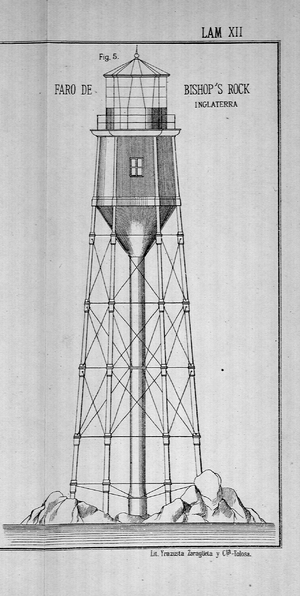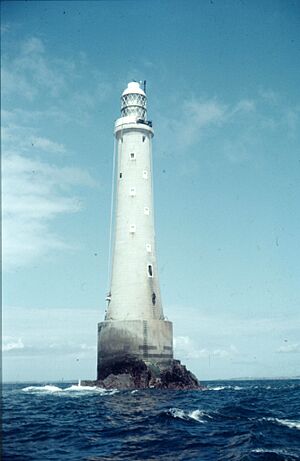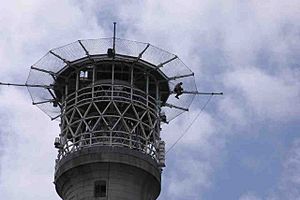Bishop Rock facts for kids
The Bishop Rock is a small, rocky island off the coast of Great Britain. It's famous for its tall lighthouse, which helps guide ships safely. This tiny island is part of the Isles of Scilly, a group of islands about 45 kilometers (28 miles) off the southwest tip of Cornwall.
The Guinness Book of Records calls Bishop Rock the world's smallest island with a building on it!
Building the first lighthouse here began in 1847, but a big storm washed it away before it was finished. The lighthouse you see today was completed in 1858. Its light first shone on September 1st of that year. Before a helipad was added, visitors had to use ropes and winches to get from the lighthouse to boats waiting below.
Bishop Rock was also important for ocean liners in the early 1900s. It marked the eastern end of a major shipping route across the North Atlantic. Ships used this route when they were trying to set speed records, a challenge known as the Blue Riband.
Contents
History of Bishop Rock
The name "Bishop Rock" has a long history. In the late 1200s, the island was called Maen Escop or Maenenescop. In the Cornish language, Men Eskop means "Bishop's Stone." Some people think the rock looks like a bishop's hat, called a mitre.
Long ago, in the 13th century, there was a harsh punishment linked to this rock. People found guilty of serious crimes were sometimes taken to a rock in the sea with just a little food and water. They were left there until the sea covered the rock.
East of Bishop Rock are the Western Rocks, Isles of Scilly. This area is known for shipwrecks. For example, in 1707, Admiral Shovell's ship, HMS Association, was wrecked here during a terrible naval disaster.
The first recorded shipwreck on Bishop Rock itself happened in 1839. A ship called the Theodorick hit the rock in foggy weather. Later, in 1842, a large paddle steamer named Brigand struck the rock with great force. It was so badly damaged that it sank, but luckily, all the crew were saved. In 1901, a sailing ship called Falkland even hit the lighthouse itself!
The Bishop Rock Lighthouse
| Coordinates | 49°52′22″N 6°26′44″W / 49.87278°N 6.44556°W |
|---|---|
| Year first lit | 1887 (rebuilt) |
| Tower shape | tapered cylindrical tower with lantern and helipad on the top |
| Markings / pattern | unpainted tower, white lantern |
| Original lens | Hyperradiant Fresnel 1330 mm Rotating |
People realized how dangerous Bishop Rock was for ships. In 1818, a report suggested building a lighthouse there, similar to the Eddystone Lighthouse. The government considered the idea, and the famous engineer John Rennie the Elder even offered to build it.
However, it wasn't until 1843 that Trinity House, the organization responsible for lighthouses in England, surveyed the rock. Under their chief engineer, James Walker, construction finally began in 1847.
Walker's First Lighthouse
James Walker first designed a 120-foot (37-meter) tall lighthouse. It was meant to have living areas and a light on top of strong iron legs. But a huge storm on February 5, 1850, washed the entire tower away before the light could even be installed. The lantern meant for this lighthouse was later used in another lighthouse called Godrevy Lighthouse.
Walker's Second Lighthouse
After the first failure, James Walker started building a new lighthouse in 1851. This time, it would be made of stone. Building it was very difficult because the rock was small and sloped. The first stone had to be placed below the lowest tide level.
Despite many challenges over seven years, the stone tower was finished without anyone losing their life. It had a special 4-wick oil lamp and a large Fresnel lens, which is a type of lens that helps make the light very bright and focused. The light first shone on September 1, 1858. This lighthouse cost about £34,559 to build.
Homes for Lighthouse Keepers
As the lighthouse was being finished, homes were built on St Mary's island for the lighthouse keepers' families. Keepers would work at the lighthouse in shifts. Three keepers would be on duty at the lighthouse, while the fourth would be on leave with their family on St Mary's.
Battling the Atlantic Storms
Walker's stone lighthouse faced the full power of the Atlantic Ocean. In bad weather, the tower would shake so much that things would fall off shelves. The shaking was even strong enough to damage the light's equipment.
A fog bell was first installed in 1858, but a storm in 1860 washed it away. A larger bell was put in its place in 1864. It would ring once every ten seconds during foggy conditions.
In April 1874, an especially strong storm hit the lighthouse. Waves as tall as 120 feet (37 meters) crashed against the tower, breaking the strong glass of the lantern. Water poured down into the living areas. Later that year, James Douglass, who had become the chief engineer, reinforced the lower part of the tower with strong iron bands.
More storms hit in 1881, ripping large granite blocks from the lighthouse. James Douglass realized the lighthouse needed major repairs. He planned to make the structure even stronger by adding huge granite blocks to the base.
Douglass's Big Renovation
James Douglass's plan was almost like building a new lighthouse! He decided to completely cover Walker's tower with new layers of granite. He also removed the old lantern and floors, making the tower 40 feet (12 meters) taller. To help the lighthouse stand up to waves, he made the base section round instead of cone-shaped.
The work started in 1883, overseen by Douglass's son, William Tregarthen Douglass. They used special equipment that had been used to build the new Eddystone lighthouse. The stones were carefully cut to exact sizes on land, then brought to the rock by ship and lifted into place. It took until 1886 to finish joining the new stonework with the old. The entire tower was completed in 1887.
New Lights and Equipment
Douglass added a tall lantern section with a special "biform" optical system. This system had two identical lamps and lens sets, one above the other. Each set used a powerful paraffin burner and large, revolving hyperradiant Fresnel lenses. The light would flash white twice every minute.
In clear weather, only the lower light was used. In foggy conditions, both lights were used at full power. This new, improved light could be seen from about 18 miles (29 kilometers) away. It was first lit on October 25, 1887. The old light equipment was later reused in other lighthouses.
The heavy new lens system was turned by a small engine powered by compressed air. This air was stored in tanks below the lantern. Compressed air could also be used to power a small winch for lifting supplies.
The lighthouse also got an explosive fog signal. In foggy weather, keepers would attach a special charge to a crane-like arm on the lantern gallery. From inside, they would raise the arm and fire the charge electrically, creating a loud bang. This explosive signal was used until 1976.
Modern Updates
In 1902, a new clockwork system was installed to turn the lenses. The lens system was even made to float in a pool of mercury, which helped it turn more smoothly. Later, brighter incandescent oil burners replaced the old ones.
In 1945, electric lamps took over from the oil burners, powered by diesel generators. A separate small generator provided electricity for the keepers' homes from 1955. This replaced an older machine that powered a radio, allowing keepers to talk directly to ships and other lighthouses.
Because it was so hard to reach the lighthouse by boat, a helipad was built on top of the lighthouse in 1976. That same year, a powerful "supertyfon" fog horn was installed.
On December 15, 1992, the Bishop Rock lighthouse became fully automated. This means it no longer needed keepers living there. The lower part of the light system is still used today, but the top part was removed and is now on display at the National Maritime Museum Cornwall. An electric fog signal replaced the supertyfon, but its use was stopped in 2007.
In 1994, a storm badly damaged the strong metal entry doors of the lighthouse. These doors also became an exhibit at the National Maritime Museum Cornwall in Falmouth.
Lighthouse Structure
Bishop Rock Lighthouse is sometimes called the "King of the Lighthouses." It is a very impressive building. At 49 meters (161 feet) tall, it is one of the tallest lighthouses in England, just like the Eddystone Lighthouse.
Building and improving the lighthouse was very expensive:
- The first iron lighthouse: £12,500
- The second granite lighthouse: £34,559
- The third improved lighthouse: £64,889
The total cost for all the work was £111,948.
Inside the lighthouse, there are 10 floors. A spiral staircase leads up to the second floor, where a metal door opens to an outside ladder. This ladder goes down to a large base, and another ladder from there leads to stone steps down to the waterline.
Before the lighthouse became automated, the floors were used for different purposes:
- 1st floor: Water tank (for fresh water)
- 2nd floor: Entrance room with the metal door
- 3rd floor: Store room (later used for fuel tanks)
- 4th floor: First oil room (later the engine room)
- 5th floor: Second oil room (later a common room)
- 6th floor: Living room for keepers (later the kitchen)
- 7th floor: Bedroom for keepers
- 8th floor: Store room (later the living room)
- 9th floor: Service room
- 10th floor: Lantern room
Bishop Rock in Culture and Media
Bishop Rock Lighthouse has appeared in many stories and shows.
In December 1946, the BBC sent two radio reporters to Bishop Rock. They were part of a Christmas program sending messages around the world. However, strong winds and rough seas trapped them and the lighthouse keepers for almost a month! Food supplies started to run low. A lifeboat finally reached them on January 16, 1947, and the reporters were carefully lowered into the boat by rope.
The lighthouse is also the subject of a short piece of orchestral music by Doreen Carwithen.
It has been a filming location for TV shows, including a BBC One ident (a short clip shown between programs). It was also featured in the documentary series Three Men in More Than One Boat and the 2010 BBC documentary Islands of Britain, presented by Martin Clunes.
In 1975, the lighthouse was shown on the popular children's TV program Blue Peter. Presenter Lesley Judd visited, and there was a scary moment when her safety harness nearly broke as she was traveling by rope to the lighthouse from a boat.
The lighthouse also appears in a short story called "Keeper of the Bishop" by A. E. W. Mason.
See also
 In Spanish: Bishop Rock para niños
In Spanish: Bishop Rock para niños
- List of shipwrecks of the Isles of Scilly
- List of lighthouses in England
Images for kids








